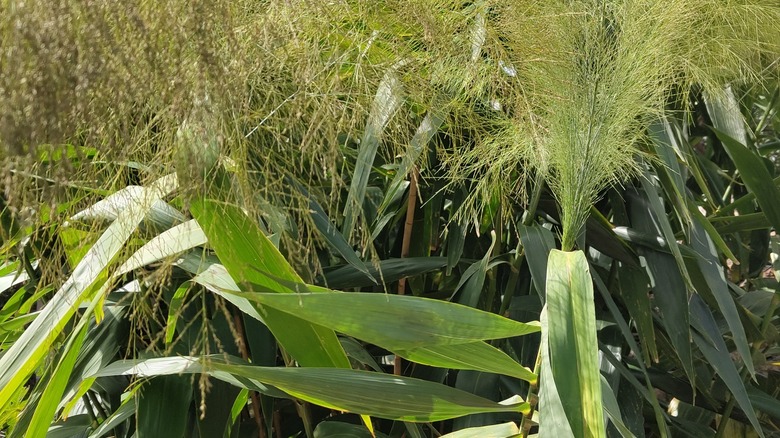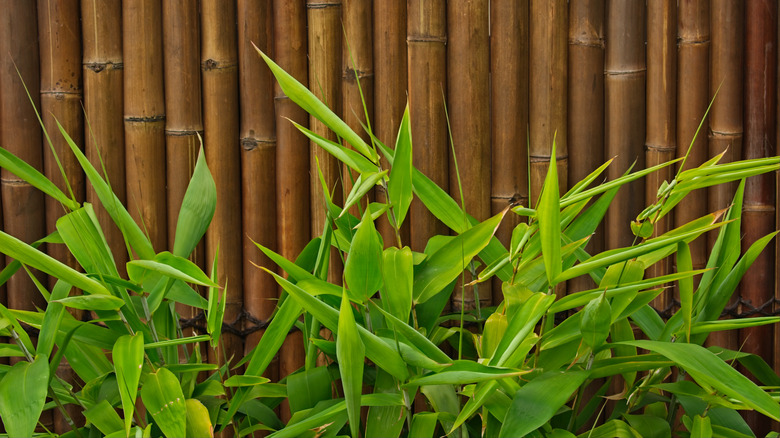Garden Trees, Shrubs & Vines
Kate Nicholson
Tiger grass evokes the exotic — it numbers among the perfect plants to grow if you live in a tropical environment. The plant, a true grass, resembles bamboo or sugarcane on steroids, lush and capacious. Despite what you may think, tiger grass doesn’t get its moniker from having orange stripes; rather, it’s camouflage for one of the world’s greatest predators in its native habitat. Adventurer and botanist David Fairchild introduced tiger grass to the U.S. in the late 19th century upon his return from Indonesia. He wrote of it (via The Ledger): “It lines the roadsides of Sumatra, where tigers scream.” Aptly, it features in the landscaping plans for the tiger enclosure at Taronga Zoo in New South Wales, Australia.
A quick online search for tiger grass most often brings up the scientific name Thysanolaena maxima, but the it was recently renamed Thysanolaena latifolia. The plant is native to Asia, specifically to Nepal, India, Bhutan, and the Philippines. There, it’s prized for its rose-mauve blooms, which are dried and turned into brooms, and its large leaves, perfect for wrapping food. It grows in a clumping manner, reaching widths of 10 feet. In warm areas (think Florida), it can grow 10 feet tall and act as an evergreen. It may die during winter in colder areas. It’s fast-growing and propagates easily by seeds and rhizomes. Gardeners can also divide the rootball.
The tall of it

Girnar/Shutterstock
Since tiger grass closely resembles the more easily found bamboo, what advantage does this ornamental grass have in your landscaping? This leggy plant has some distinct advantages over its more common counterparts. While tiger grass grows best in well-watered, nutrient-dense soil, it’s widely touted as tolerant of drought and poor soil quality. It may not reach its full height and breadth under sub-optimal conditions, but it will still grow well. “This eastern Asia native grass is a very tough plant,” professional landscaper Eric Larson says in his weekly Mansfield News Journal gardening column. “My clients can easily take care of this plant without much stress.”
According to Plant Signaling & Behavior, tiger grass encourages biological diversity in larger landscapes and agricultural settings by sheltering smaller plants and animals. It grows incredibly quickly, helping reverse land degradation in the process (per Solid Earth) — like other grasses, its extensive root systems bolster soil against erosion, as noted by published research in Catena. Farmers in the Philippines refer to it as a “guardian of the soil” for this reason (via SAAD). Practically, its tendency to form large clumps makes it perfect for creating screens and hedges — say, around pools or patios. In an evergreen windbreak, the trees can’t be planted too closely together; use tiger grass to fill the gaps between trunks. Additionally, tiger grass is really pretty in the garden, its immense ethereal blooms and seed heads contrasting dramatically with its bold, grass-green leaves affixed to unforgiving stems.
In your garden

A.Flassig/Shutterstock
Growing tiger grass isn’t all warm, breezy tropical vibes. The main downside to this boisterous plant seems to be accessibility. Tiger grass remains underutilized — even, dare we say it, rare — in the U.S. It’s not yet stocked by many nurseries, and seeds are tricky to germinate. But it can be found. Florida plant nursery Wellspring Gardens sells seedlings 3 to 8 inches tall for $16.99 each. Walmart has rooted starter plants for (an admittedly rather pricey) $28.53.
Seedlings in hand, it’s time to get planting. Tiger grass prefers partial shade but will also do well in full sun, provided it gets regular hydration during drier months. If you live in a colder climate, choose the sunniest spot in your garden. Once you know where you want to put your new plant, all that’s left is to dig a hole about three times wider than the rootball, gently loosen the roots with your fingers (not a tool — the metal risks damaging the tendrils), and pop the plant into the hole. Top with soil and any soil amendments you want to add, whether compost, fertilizer, or mulch. Gently water the area. In winter and spring, cut browning stems to the ground using hand pruners or hedge trimmers. Fertilize newly-planted tiger grass a few times a year. It likes an occasional handful of compost. Check periodically for disease. The main culprit is Exserohilum leaf spot, indicated by tan-colored blotches on the leaves.



